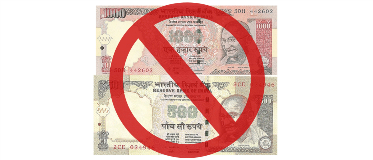10 things you should know about Rs. 500 and Rs. 1,000 discontinuation

In an attempt to curb black money and corruption, Prime Minister Narendra Modi in an unscheduled meeting announced demonetisation of of Rs. 500 and Rs. 1,000 currency notes with effect from midnight of November 8th 2016. In March 2016, around 88% of the total currency consisted of Rs. 500 and Rs. 1,000 notes. Naturally, this move has created a lot of panic among the people of India.
Here’s where and when you can exchange/deposit your money...
| Process | Limit | Where | Time-Frame |
|---|---|---|---|
| Exchange | Rs. 4,000 | Bank and Post Office | 10th Nov to 24th Nov, 2016 |
| Exchange | More than Rs. 4,000 | Any Personal Bank or any Post Office | 25th Nov to 30th Dec, 2016 |
| Deposit | No Limit | Banks and Post-Office | 10th Nov to 30th Dec, 2016 |
| Deposit | No Limit | RBI specified offices | 31st Dec to 31st March, 2017 |
Here are 10 things you should know about the discontinuation of Rs. 500 and Rs. 1,000 currency notes:
-
All the residents of India who are holding currency notes of Rs. 500 and Rs. 1,000 have the option to deposit their cash in bank accounts or post office by 30th December 2016.
-
One can exchange old notes of Rs. 500 and Rs. 1,000 at any bank, post office, by showing a valid ID proof. However, the limit for this is Rs. 4,000 upto 24th November, 2016.
-
There would be no restrictions on online transactions, cheque, debit/credit card or any other plastic money transactions.
-
New notes of Rs. 500 and Rs. 2,000 would be brought into circulation from November 10, 2016.
-
People who are unable to deposit the old currency notes by 30th December, 2016 for some reason, have the option to change them by 31st March, 2017 by presenting a valid ID proof.
-
The old currency notes will be valid for transactions related to railway booking, air ticket booking, bus ticket counters and government hospitals till the midnight of November 11 and 12, 2016.
-
ATMs to remain shut on November 9 and 10, 2016.
-
The withdrawal limit for cash against cheque has been set to Rs. 10,000 per day and Rs. 20,000 per week upto 24th November. The limits shall be reviewed post this.
-
After the ATMs are functional, one can withdraw upto a maximum of Rs. 2,000 per card per day upto 18th November, 2016. The limit will be raised to Rs. 4,000 per day per card from 19th November, 2016.
-
People who do not have a bank account can open an account by approaching the bank with necessary documents needed for fulfilling the KYC formalities.
Please Note: You can refer to www.rbi.org.in for further information and the website of the Government of India (www.finmin.nic.in). You may also approach the control room of RBI by email or contact them on 022 22602201/022 22602944.
- Flat ₹20 Brokerage
- Next-gen Trading
- Advance Charting
- Actionable Ideas
Trending on 5paisa
Disclaimer: Investment in securities market are subject to market risks, read all the related documents carefully before investing. For detailed disclaimer please Click here.
 5paisa Research Team
5paisa Research Team
 Sachin Gupta
Sachin Gupta